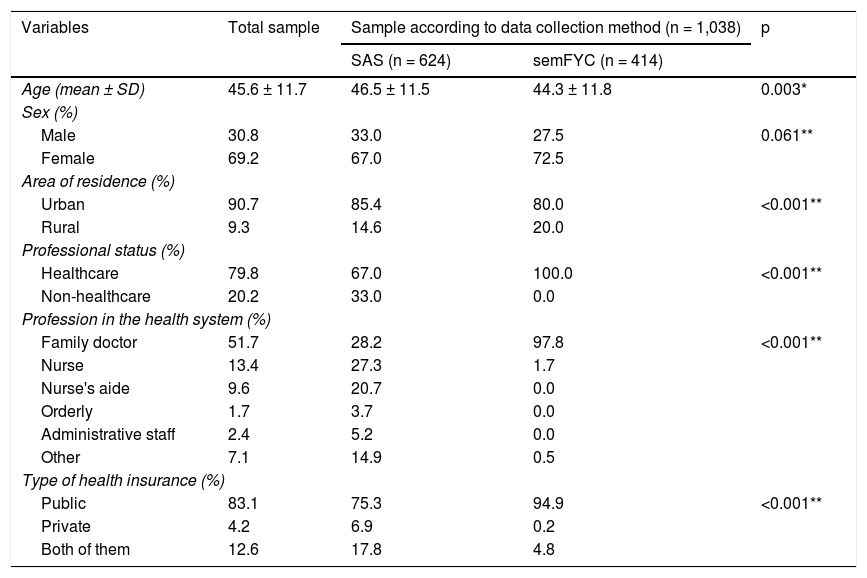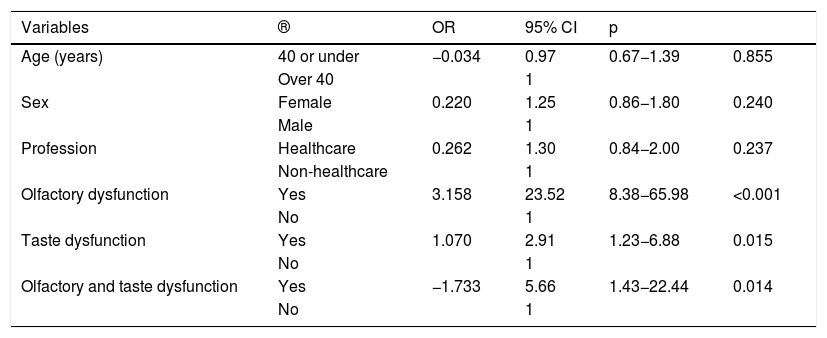Olfactory and taste dysfunction (OD, TD) have been considered symptoms of SARS-CoV-2 infection. However, its presence in certain populations, especially those with mild clinical symptoms, has not been clarified. The objective was to estimate the frequency of OD and TD, and its predictive validity in patients detected in Primary Care.
Patients and methodsA cross-sectional study was carried out in the Spanish National Health System. An epidemiological survey was administered to patients who were requested the PCR test for SARS-CoV-2. Odds ratio (OR) were estimated to measure the magnitude of the association between OD and TD and the existence of SARS-CoV-2 infection. The sensitivity, specificity, and positive and negative predictive values (PPV, NPV) of these symptoms in SARS-CoV-2 infection were calculated.
ResultsOf 1038 patients screened, 20.1% had SARS-CoV-2 infection. OD and DG were present in 64.4% (95% CI 56.0–72.1) and 56.2% (95% CI 47.9–64.2) of the subjects with infection, respectively. The OR for OD was 12.2 (95% CI 8.26–18.06) and for TD was 7.95 (95% CI 5.48–11.53). TD presented a sensitivity of 41.1% (95% CI 34.4–46.1), a specificity of 91.9% (95% CI 89.8–93.7), a PPV of 56.2% (95% CI48.0–64.2) and a NPV of 86.1% (95% CI 83.6–88.3), while the OD showed a sensitivity of 45.0% (95% CI 37.6–51.5), a specificity of 93.7% (95% CI 91.8–95.0), a PPV of 64.4% (95% CI 56.0–72.1) and a NPV of 87.1% (95% CI 84.7–89.2).
ConclusionsMore than half of the subjects with SARS-CoV-2 infection have OD or TD. The presence of OD or TD could be of diagnostic utility due to its ability to predict infection in more than half of the cases.
La disfunción olfatoria (DO) y gustativa (DG) han demostrado ser síntomas de la infección por SARS-CoV-2. Sin embargo, su presencia en determinadas poblaciones, sobre todo en aquellas con cuadros clínicos leves, aún debe aclararse. El objetivo fue estimar la frecuencia de DO y DG, y su validez predictiva en pacientes detectados en Atención Primaria.
Pacientes y métodosSe realizó un estudio transversal en el Sistema Nacional de Salud español. Se administró una encuesta epidemiológica dirigida a pacientes a los que se les solicitó la prueba PCR para SARS-CoV-2. Se estimaron las odds ratio (OR) para medir la magnitud de la asociación entre la DO y DG y la existencia de infección por SARS-CoV-2. Se calculó la sensibilidad, la especificidad y los valores predictivos positivos (VPP) y negativos (VPN) de estos síntomas en la infección por SARS-CoV-2.
ResultadosSe captaron 1.038 pacientes, de los cuales el 20,1% presentaban infección por SARS-CoV-2. Las DO y DG estuvieron presentes en el 64,4% (IC 95% 56,0–72,1) y el 56,2% (IC 95% 47,9–64,2) de los sujetos con infección, respectivamente. La OR para la DO fue de 12,2 (IC 95% 8,26−18,06) y para la DG de 7,95 (IC 95% 5,48−11.53). La DG presentó una sensibilidad del 41,1% (IC 95% 34,4–46,1), una especificidad del 91,9% (IC 95% 89,8–93,7), un VPP del 56,2% (IC 95% 48,0–64,2) y un VPN de 86,1% (IC 95% 83,6–88,3), mientras que la DO mostró una sensibilidad del 45,0% (IC 95% 37,6–51,5), una especificidad del 93,7% (IC 95% 91,8–95,0), un VPP del 64,4% (IC 95% 56,0–72,1) y un VPN del 87,1% (IC 95% 84,7–89,2).
ConclusionesMás de la mitad de los sujetos con infección por SARS-CoV-2 presentan DO o DG. La presencia de DO o de DG podría ser de utilidad diagnostica por su capacidad para predecir la infección en más de la mitad de las ocasiones.











